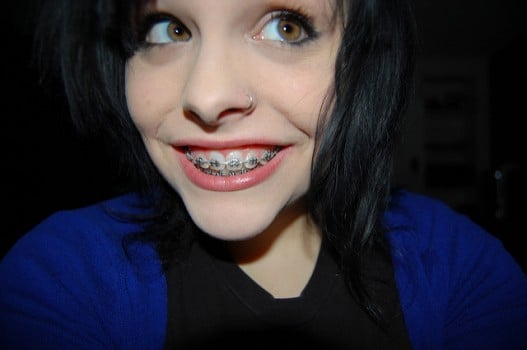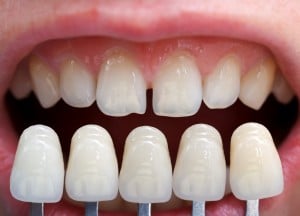Naturally, you want the quickest and most painless path toward a perfect smile, as well as one that will achieve lasting results. If your journey includes orthodontic treatment, there are several types of braces to consider. You also might have heard of dental veneers as an alternative to orthodontic treatment. Here is what you need to know about both methods, as well as a comparison between cost, treatment and effectiveness.
What Are Braces?
Dental braces are devices that orthodontists use to shift tooth movement gradually over time. They are used to correct misalignments of the teeth, as well as various abnormalities related to the bite.
Though some dentists will treat basic alignment issues, orthodontists are typically are involved in treatment with braces. These specialists are experts in correcting teeth irregularities.
Treatment time varies by individual, but on average patients spend between one and three years in braces. Regular visits to the orthodontist are required during the treatment period, so he can monitor progress and make adjustments. The cost you can expect for treatment with metal braces is about $5,000 (without insurance). The price will be higher for other types of braces such as ceramics or clear aligners.
Traditional braces are composed of brackets that the orthodontist attaches to the front of the teeth, stainless steel bands that are cemented to the teeth, archwires that attach to the brackets and guide tooth movement, and small elastic bands that attach to brackets. Metal braces have a broad range of shapes, styles and accessories, allowing wearers to personalize their look. Other options for braces include:
Ceramic
A glass-like composite composes ceramic braces, which makes them slightly more expensive and take slightly longer to complete treatment than traditional braces. However, these clear brackets have cosmetic appeal for more self-conscious wearers.
Plastic
Plastic braces are another alternative for wearers who wish to minimize their braces’ visibility. Comprised of ceramic- or fiberglass-reinforced polycarbonate, they have a transparent, “tooth-colored” appearance, but often have longer treatment periods.
Plastic Trays
Made from polypropylene, these retainer-style plastic trays (known as aligners) are molded to fit over the teeth, with the most popular brand being Invisalign®. They are clear and removable for dental hygiene and eating. However, they are not as effective in complex orthodontic procedures and for certain malocclusions.
 What Are Veneers?
What Are Veneers?
Dental veneers are thin, custom-made shells of tooth-like material designed to cover the front surface of the teeth to improve their appearance. Two types of dental veneers exist:
- Porcelain Veneers: Resist stains and mimic the light-reflecting properties of natural teeth
- Resin Veneers: Thinner and require removal of less tooth surface before placement
Veneers are routinely used to fix:
- Teeth that are discolored. This could be from a variety of reasons such as the result of root canals, medications, excessive fluoride use or filled cavities that have altered the appearance of the tooth
- Teeth that are worn down, chipped or broken
- Teeth that are irregularly shaped or have gaps between them
Which is right for me?
To determine whether braces or veneers are most appropriate, you and your orthodontist will have to weigh the pros and cons of each, as well as factor in the health of your teeth and your cosmetic goals. Additionally, determining the number of teeth (usually most of them) that will require veneers can help you make a decision from a financial standpoint.
Braces: Pros
Braces leave your teeth intact, so they are a non-invasive way to straighten your smile. Additionally, braces can correct alignment issues with the jaw or bite, which can affect your overall health. Left untreated, malocclusions (misalignments) can cause many physical problems including:
- Tension headaches
- Inflammation of the jaw joints (TMJ)
- Earaches
- Neck pain
- Receding gums
- Loose teeth
- Tooth loss
If you have any of these conditions, it is wiser to invest the time in orthodontic treatment.
Braces: Cons
Most people consider the biggest drawback of braces to be the treatment time, as well as the long-term aftercare needed to maintain results. The treatment period in braces usually is followed by the use of a retainer to prevent teeth from moving back to their original positions. Your orthodontist will typically ask you to wear a retainer all the time for several months after removing your braces, and at night for several years more.
Veneers: Pros
Dental veneers were designed with the intent of treating broken, worn or badly discolored teeth. However, their convenience has made them a popular alternative to orthodontic treatment.
If you are looking for immediate results, veneers require just three visits to the dentist—one for a consultation and two to make and apply the veneers. If you are not great about following the doctor’s orders, there won’t be any with veneers—they do not typically require any special aftercare beyond good oral hygiene practices.
Veneers: Cons
Dental veneers can be quite pricey, with typical costs above $1,000 per tooth. They also will need to be replaced every five to 10 years. Another drawback is that you will, in a sense, damage healthy teeth. If your only issue is misalignment, then you should consider how many teeth you will alter by placing veneers on them. To get the even look and spacing that orthodontic work achieves, you likely will need veneers on almost all your teeth. If a large number of teeth are treated, it could drastically increase the cost.
How do they compare?
| Braces | Veneers | |
| Cost | About $3,000 to $5,000 total cost depending on insurance | $1,000 to $1,300 per tooth (usually not covered by insurance) |
| Treatment Period | 1 to 3 years in braces, followed by a retention phase | 2 visits |
| Effectiveness | Highly effective for: misaligned teeth, underbite, overbite, other structural abnormalities | Highly effective for: broken teeth, discolored teeth, irregularly shaped teeth, gaps between teeth |
| Duration of Results | Permanent (if retainer is worn as prescribed) | 5 to 10 years |
If you are uncertain what approach best suits your treatment goals, one of our experts at Orthodontic Associates can help determine the best route to a perfect smile. The orthodontist will recommend a treatment plan based on your needs, and help you to regain an attractive smile, while maintaining the health of your teeth. Contact one of our friendly staff members to set up a consultation at any one of our nine convenient orthodontic offices around Baltimore. We look forward to making you smile!



 What Are Veneers?
What Are Veneers?